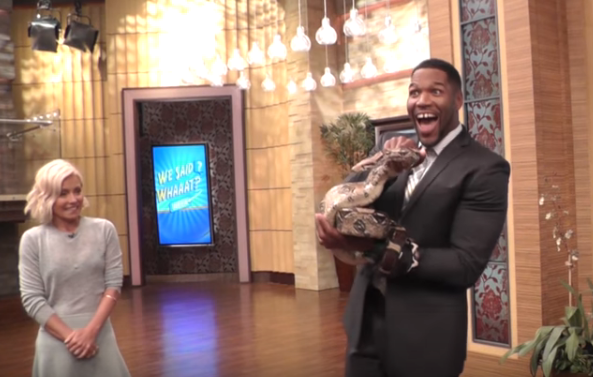Steve Andreas is an American psychotherapist and author specializing in Neuro-linguistic programming.
On his blog he did a post about the Richard Bandler appearance on the Kelly and Michael show.
Bandler does a phobia removal strategy that is super quick and masterfully executed.
Steve Andreas shares his thoughts on it...
1:20
Bandler’s instruction: “Take that picture, shrink it down to the size of a quarter—prrrrup—and blink it black and white”—is accompanied by quick and definitive hand gestures. “Shrink it down to the size of a quarter” makes the image so small that it will elicit a much less intense emotional response, and moving it lower in the visual field will make it less important. “Black and white” takes the color out of it, reducing its emotional impact further, and “blinking it” repeatedly interrupts the image and any remaining response.
 As Bandler does this, his left hand is behind Michael’s back, and it looks as if he is anchoring Michael’s response on his back or shoulder. He continues to keep his arm in this position until 3:30 when the video is interrupted by a commercial break.
As Bandler does this, his left hand is behind Michael’s back, and it looks as if he is anchoring Michael’s response on his back or shoulder. He continues to keep his arm in this position until 3:30 when the video is interrupted by a commercial break.
1:50
Bandler says, “Clear your mind for a minute,” as his right hand waves in front of Michael’s face, insuring that any images he may be making are wiped away, followed by “Look at me.”
These two commands are followed by, “Now look at the picture and try to be afraid. “Try” presupposes that it will be difficult to be afraid. Michael looks a little surprised, congruently saying, “I’m good.”
A little later, Bandler says, “Now that the picture’s out of your mind,” presupposing that it is out of his mind. All nice work, flawlessly delivered.
Bandler then tests by asking Michael to make two pictures, one of him being terrified, and the other of him going over and touching a snake, and choose which he’d rather be. Michael says he prefers being terrified—which I understand to be a conscious mind answer based on his past experience of being afraid. When Bandler says, “When you look at yourself going over and touching a snake do you look afraid?” Michael says, “No,” indicating an unconscious change in response.
Bandler appears to be holding the anchor during this testing, which is a useful way of making sure that it works, especially in the context of a public demonstration. However, if he had not used the anchor, it would have been a better test of whether or not the change was complete.
With his hand still on Michael’s back, Bandler then points out to him all the time wasted, both in the past and future, by having the phobic response, and what he could do with all that time, to motivate him to choose the picture of touching the snake. When Bandler says “ten minutes a day, 352 days a year” (instead of 365 days) that is a clever distraction of Michael’s conscious mind. Shortly after that the video is interrupted for a commercial break; it would be very interesting to know what else Bandler did during the segment that was omitted from the video.
The video begins again with testing, with Kelly holding a huge snake, and Bandler slowly walking with Michael toward the snake, touching the snake, and eventually holding it.
It’s worth noting that the pre-test, (having a snake thrown at him unexpectedly) is very different from the post-test (seeing a snake at a distance and then voluntarily walking over to touch it and hold it).
Some might say that the post-test was more intense, since it was a much larger, and real snake, rather than a smaller toy snake. However, not all people are more afraid of a large snake than a small one, and having the snake come at him suddenly and out of his control is very different than seeing the snake, and choosing to slowly walk over to touch it. Ideally, the pre-test and post-test should be identical—same snake, same conditions, so that any difference in response can be securely attributed to the intervention, and not to other variables.
I think there is also some question whether Michael really had a “huge” phobia to start with. At 1:20, just after Bandler asks Michael, “Remember when she threw the snake at you?” Michael says, “Oh, yeah,” but I don’t see the kind of nonverbal responses I would expect to see if he had a phobia.
A TV host’s job is to put on a good show, and in a variety of situations this will require good acting ability to accomplish that. Furthermore, the context of a TV show, with all the preparation and expense, and with a live audience watching and listening to one of the TV hosts (in contrast to a volunteer from the audience) exerts considerable pressure to respond as expected.
A case in point is Bandler’s 2008 video of working with a woman with an airplane phobia in “The Hypnotist.” At the end of part 2, it is quite clear from both her verbal report and her nonverbal response that she still has her phobia of flying, yet the video (which must have cost a bundle to produce) is presented as a success by “the world’s leading hypnotist.”

















